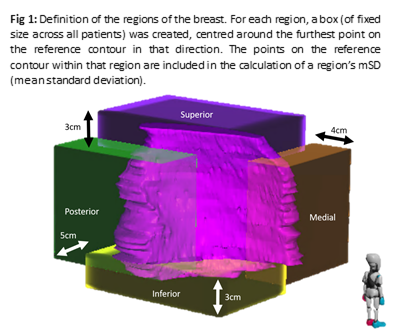The importance of regional analysis in contour comparison
Hannah Chamberlin,
United Kingdom
PO-1616
Abstract
The importance of regional analysis in contour comparison
Authors: Hannah Chamberlin1, Edward Henderson1, Richard Cowan2, Carmel Anandadas2, Fiona Wilson2, Christina Hague2, Clara Chan2, Lucy Davies3, Mairead Daly1, Cynthia Eccles3, Margaret Harris2, Maria Maxwell3, Zhu-Chuen Oong2, Zoe Turpin3, John Radford2, Sacha Howell2, Sue Astley4, Marianne Aznar1, Eliana Vasquez Osorio1
1University of Manchester, Radiotherapy Related Research Group, Division of Cancer Sciences, Manchester, United Kingdom; 2The Christie NHS Foundation Trust, Department of Clinical Oncology, Manchester, United Kingdom; 3The Christie NHS Foundation Trust, Radiotherapy, Manchester, United Kingdom; 4University of Manchester, Division of Informatics, Imaging and Data Sciences, Manchester, United Kingdom
Show Affiliations
Hide Affiliations
Purpose or Objective
Metrics such as the Dice coefficient (DSC) and mean distance to agreement (mDTA) are often used to quantify delineation variation between multiple observers or the performance of autocontouring, but fail to capture variations in specific regions where contours disagree. These variations have implications for margin definition and RT dose to the target and healthy tissues. Here, we demonstrate the value of regional analysis applied to variation quantification between multiple observers in regions of the breast.
Material and Methods
CT scans of 10 female lymphoma patients (age 15 to 34) were selected, and a reference breast contour was drawn manually and peer-reviewed by 2 breast oncologists using ESTRO consensus guidelines. In addition, auto-contours were produced using an atlas-based contouring tool in RayStation (RaySearch, Sweden) using 10 templates (also to ESTRO guidelines) and manually edited by 10 observers (lymphoma clinicians and radiographers).
Global measures of contour similarity between each edited and reference contour included DSC and mDTA. We calculated mDTA as the average of bidirectional local distances (BLDs) quantified at every point on the reference contour relative to each edited contour. Regions of the breast were defined as illustrated in Fig 1 to ensure reproducibility and consistency over the patient cohort. Variations between observers are reported as the standard deviation (SD) of the 10 BLDs on each point, averaged over all contour points (global mSD) and for each region (regional mSD). We report the values for the left breast only, but results were similar for both breasts.

Results
Agreement between reference and edited contours was good (Table 1). The mean DSC was >0.88 for all patients and individual DSC values were always >0.75. The mean of mDTA was <4.1mm for all patients. Global mSD ranged between 0.95 and 3.31mm, also interpretable as good observer agreement. However, regional analysis shows superior mSD was greatest for all but 1 patient, ranging between 2.32mm and 12.36mm (Fig 2). This suggests a higher level of disagreement between observers at the superior region of the breast.
The SD of mDTA and the regional mSDs were significantly correlated in the global, medial and superior regions, but not the posterior or inferior region (Pearson correlation, Fig 2). This suggests the regional mSDs offer valuable supplementary information about contour variations. Similarly, the SD of DSC and regional mSDs were only significantly correlated for the global and superior regions.
Table 1: Mean metrics per patient
| Patient | 1 | 2 | 3 | 4 | 5 | 6 | 7 | 8 | 9 | 10 |
Mean mDTA (mm)
| 2.05
| 3.19
| 4.08
| 1.87
| 3.20
| 3.16
| 2.48
| 3.27
| 2.24
| 2.42
|
Mean DSC
| 0.94
| 0.89
| 0.88
| 0.94
| 0.91
| 0.89
| 0.93
| 0.91
| 0.93
| 0.93
|

Conclusion
The regional analysis of contour similarity identifies sources of deviation between observers, unavailable with global metrics. Evaluation of regional deviation will aid clinicians to identify where to focus while reviewing contours, and potentially indicate regions of contouring guidelines which require stricter definition.